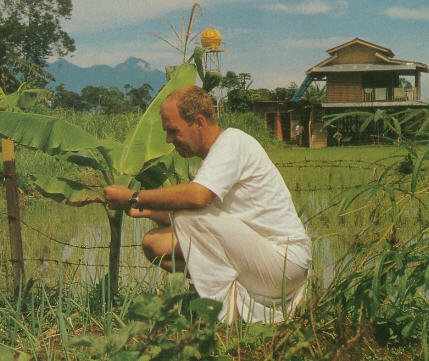Devotees on the Hare Krsna farm near Jakarta hope to demonstrate
the wisdom of the Vedic culture that once flourished in Indonesia.
FOR ME THE ISLAND OF JAVA always stood as a land of mystery and adventure. From stories of prehistoric Java Man to tales of sailors of yore shipwrecked off the island's rocky coast, my mind was always fascinated by this largest of the islands in the archipelago now called Indonesia. So with great expectations I accepted the invitation of my Godbrother Gaura Mandala Bhumi Dasa to visit Indonesia and New Govinda Kunja, ISKCON's small farm community just outside the capital city, Jakarta.

Dayasara Dasa Inspects a Young Plant
When I arrived on the island, the hustle and bustle of Jakarta's streets soon dispelled any fears I had of savage tribes roaming the jungles of a desolate island. Java is the most populous island in the world (130 million people). It's a predominantly Muslim country with fewer than ten million Hindus.
"Srila Prabhupada visited Jakarta in 1973," said Dayasara Dasa, president of the farm, as we headed north from the city on a one-hour drive to New Govinda Kunja. "Now, like then, we spread Krsna consciousness mostly among the Indian community and to the tourists who visit the island. Though the law guarantees religious freedom, we're not allowed to teach Krsna consciousness to the Muslims.
"We started our farm on Srila Prabhupada's aphorism 'simple living and high thinking.' He wanted Krsna conscious farm communities that would show how to live self-sufficiently, and Indonesia is an ideal place for that. Eight out of ten people here live on farms."
As we drove through the fertile valleys to our community, nestled in a prominent area of retreats, Dayasara said, "Historians say Indonesia was once part of the Vedic culture of India. We still find many remnants of that culture here."
I thought of ancient Dvaraka, described in Vedic scriptures as surrounded by flower gardens, fruit orchards, and reservoirs full of lotuses. No mention of factories or slaughter-houses. "Hard to find a place like Dvaraka now," I said.
Smiling, Dayasara turned to me and said, "You'll be seeing it in five minutes. New Govinda Kunja is just over the hill."
As we entered the farm, I was struck by the devotees' expert use of space.
"It's a small farm," said Dayasara. "Two and a half acres. We've kept it like that because it's what we can handle. We're only ten devotees here."
I looked out over the fruit trees, many of which I couldn't identify. Dayasara pointed them out tapioca, papaya, coconut, mango, mangosteen, rambhutan, jambhu, guava, sahalak, jackfruit, durian.
As we passed the small rice field, devotees working under the hot sun looked up from beneath big straw hats and smiled and waved.
"Do you irrigate?" I asked.
Laughing, Dayasara replied, "We don't need to. This is the Puncak Valley. More rain falls here than anywhere else in the world."
"The Puncak Valley is also famous for those two mountains, Gunung Gede and Guna Salak," he said, pointing to two enormous mountains on either side of the valley. "They're two of the forty active volcanoes on Java. We're the most volcanic island in the world."
An ominous cloud of black smoke belched from the crater of one of the volcanoes. Dayasara didn't seem concerned, so I decided not to worry about it myself. After all, I'd only be here a week.
"An advantage of rural life is that you can build your own house cheaply," said Dayasara as we stopped in front of a Balinese-style home. "Our devotees built all the houses on the land, mostly from bamboo."
As we entered the home, a surprisingly cool structure, he showed me the walls and ceiling, woven by devotees from split bamboo.
"No glass windows?" I asked.
"No need," he said. "We only have two seasons: hot and dry. It never gets cold. It's like a replica of the spiritual world."
From the window we could see the barn where Yamuna, the devotee's cow, lives with her calf, Sita.
"Yamuna's famous in the region," said Dayasara. "She's still giving milk after a year. Most cows give milk only six months."
"How's that?" I asked.
"It's simple," Dayasara replied. "She feels welcome here."
I knew what he meant. I too felt welcome at New Govinda Kunja and looked forward to my next visit to this spiritual oasis. Of course, I'd keep my eye on Guna Salak.
Indradyumna Swami travels around the world spreading Krsna consciousness. He's based at the ISKCON temple in Durban, South Africa.
To know more about Indradyumna Swami, visit www.indradyumnaswami.com
